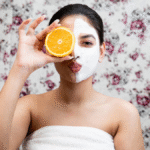Exfoliation is a fundamental component of any effective skincare routine. Whether you want glowing skin, fewer breakouts, or smoother texture, exfoliation can help. This comprehensive guide will explore the types of exfoliation, their benefits, how to exfoliate safely, and expert tips to incorporate into your skincare regimen.
What Is Skin Exfoliation?
Skin exfoliation is the process of removing dead skin cells from the surface of your skin. This helps unclog pores, prevent acne, and promote cell turnover, resulting in healthier, more radiant skin.
Why Do We Need Exfoliation?
Our skin naturally sheds dead cells, but sometimes these cells don’t slough off completely. This can lead to clogged pores, dullness, and rough texture. Regular exfoliation helps:
- Improve skin tone and texture
- Prevent acne and blackheads
- Enhance absorption of skincare products
- Stimulate collagen production
Types of Exfoliation
There are two main types of exfoliation: physical and chemical. Both have their own set of methods, tools, and benefits.
Physical Exfoliation

This involves manually scrubbing the skin to remove dead cells using tools or granular substances.
Common Methods:
- Scrubs with particles like sugar, salt, or ground nutshells
- Exfoliating brushes or sponges
- Microdermabrasion devices
Pros:
- Instant smoothness
- Easy to use at home
Cons:
- Can be abrasive for sensitive skin
- Risk of microtears if used too aggressively
Chemical Exfoliation
Chemical exfoliants use active ingredients to dissolve dead skin cells without manual scrubbing.
Common Ingredients:
- Alpha Hydroxy Acids (AHAs): Glycolic acid, lactic acid (ideal for dry or sun-damaged skin)
- Beta Hydroxy Acids (BHAs): Salicylic acid (best for oily and acne-prone skin)
- Polyhydroxy Acids (PHAs): Gluconolactone, lactobionic acid (gentler alternatives for sensitive skin)
Pros:
- More even exfoliation
- Can target deeper skin layers
- Less abrasive
Cons:
- Requires sun protection
- May cause irritation if overused
Benefits of Exfoliation
Regular exfoliation can have a significant impact on skin health and appearance.
1. Brighter Skin
By removing dead skin cells, exfoliation reveals fresh, new skin beneath, enhancing your natural glow.
2. Smoother Texture
Exfoliation helps minimize rough patches, giving your skin a silky feel.
3. Fewer Breakouts
Clearing clogged pores reduces acne and blackheads.
4. Better Product Absorption
Freshly exfoliated skin is more receptive to serums, moisturizers, and treatments.
5. Anti-Aging Effects
Stimulating cell turnover can soften fine lines and improve skin elasticity over time.
How to Exfoliate Safely
Over-exfoliation can damage your skin barrier, leading to irritation, redness, and dryness. Here’s how to do it right.
Step-by-Step Guide:
- Choose the Right Exfoliant: Match the method to your skin type.
- Cleanse First: Start with a gentle cleanser to remove dirt and makeup.
- Apply Exfoliant:
- For physical: Massage in circular motions for 30 seconds
- For chemical: Apply evenly and follow product instructions
- Rinse Thoroughly: Use lukewarm water to remove residue.
- Moisturize: Follow up with a hydrating moisturizer.
- Use Sunscreen: Always apply SPF after exfoliating to protect sensitive new skin.
Frequency of Exfoliation
- Oily/Acne-Prone Skin: 2-3 times a week
- Dry/Sensitive Skin: 1-2 times a week
- Normal/Combination Skin: 2 times a week
Exfoliation by Skin Type
Tailoring your exfoliation approach to your skin type ensures better results and fewer side effects.
Oily Skin
- Best Options: Salicylic acid, clay masks, exfoliating brushes
- Benefits: Helps control excess oil and prevent breakouts
Dry Skin
- Best Options: Lactic acid, gentle scrubs with moisturizing ingredients
- Caution: Avoid harsh scrubs; focus on hydration
Sensitive Skin
- Best Options: PHAs, enzyme exfoliants
- Tip: Always patch test new products
Combination Skin
- Best Options: Use different products on different areas
- Strategy: Balance exfoliation and hydration
Expert Tips for Effective Exfoliation
1. Listen to Your Skin
Tightness, redness, or flaking are signs you may be over-exfoliating.
2. Don’t Mix Too Many Actives
Combining multiple acids or retinol with exfoliants can irritate your skin.
3. Nighttime is Best
Your skin regenerates overnight, making evening exfoliation more effective.
4. Use Gentle Pressure
Let the product do the work. Avoid scrubbing too hard.
5. Follow With Soothing Ingredients
Look for moisturizers with hyaluronic acid, ceramides, or aloe vera.
DIY Exfoliation Recipes
Sugar and Honey Scrub
- 1 tbsp sugar
- 1 tbsp honey
- Mix and gently massage onto the skin
Yogurt and Oatmeal Mask

- 2 tbsp yogurt
- 1 tbsp ground oats
- Apply for 10-15 minutes, then rinse
When to Avoid Exfoliation
- After sunburn
- While using prescription retinoids unless advised
- During active eczema or rosacea flare-ups
- If your skin feels irritated or inflamed
Also Read: The Perfect Night Skincare Routine For Glowing Skin
Conclusion
Exfoliation is a powerful tool in skincare when done correctly. It can brighten your complexion, clear breakouts, and help your skincare products work better. Understanding your skin type and choosing the right exfoliation method is key. With the right technique and frequency, you can achieve radiant, healthy skin safely and effectively.
FAQs
1. Can I exfoliate every day?
Daily exfoliation is generally not recommended. Over-exfoliating can damage the skin barrier. Most skin types benefit from 1-3 times per week.
2. What’s the difference between AHAs and BHAs?
AHAs are water-soluble acids that work on the skin’s surface, great for dry skin. BHAs are oil-soluble and penetrate deeper into pores, ideal for oily or acne-prone skin.
3. Is exfoliation good for aging skin?
Yes. Exfoliation promotes cell turnover and collagen production, which helps reduce fine lines and improve elasticity.
4. Can exfoliation cause breakouts?
It can if overdone or if the wrong product is used. Start slow and choose the right exfoliant for your skin type.
5. Should I exfoliate before or after shaving?
Exfoliate before shaving to remove dead skin and help prevent ingrown hairs.





